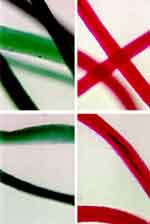
Fibers under the microscope
Clothes,
Fabrics and the Fiber Evidence
Eighty-three items of clothing were
seized during the search and arrests. The clothes included 46
shirts, 10 pairs of pants, 5 pairs of shoes, 5 pairs of underwear, 4
pairs of socks, and 3 shorts. Of the shirts, 29 are described
as black, usually with a design. These designs included 16 heavy metal
bands (15 from Baldwin's household and one from Misskelley's), 1
country music, 2 sports teams (Rangers and Bulls), and 2 with Harley
Davidson. Nine non-clothing fabric items were seized.
The seizures appeared utterly random. One pair
of pants was taken from the Misskelley residence, six from Baldwin's,
and three
from Echols'. A throw rug was seized from the closet in the
Baldwin household, and a piece of carpet from the Echols', but no floor
item came from Misskelley's trailer. Two blankets, one from
the grandmother's bedroom, and a sheet were collected from Echols'
house
and a heating pad cover was taken from the Baldwin's place.
The seizures included the parents clothes (four housecoats) and clothes
from siblings (a child's Garanimals brand shirt played prominently in
the trial). One reason for the differences in the selected items
is that Lisa Sakevicius, the criminologist who would later test the fibers for
similarities was present at some of the searches but not others. As she said in court:
Sakevicius:
. . .none of this case has been common practice for me. This is
the first time I ever participated in a search of Defendants' or
victims' homes. [Echols/Baldwin trial abstract]
Fibers Collected for Analysis
The victims bodies and their clothes were examined
for anomalous fibers
to identify the possible source of these among the clothes and fabrics
entered
into evidence. Fibers were collected from other evidence to
try to connect such evidence to the victims' clothes. The
specimens listed in the following section were deemed to have
similarities to fibers from other evidence items by the Arkansas State
Crime
Laboratory (ASCL) and the Alabama Department of Forensic Science
(ADFS). Lisa Sakevicius of ASCL testified extensively at the
trials and John Kilbourn of ADFS testified at the Echols/Baldwin trial.
Significant Fibers
Seven sets of fibers were found to have
similarities to fibers from other evidence items. These are presented below. The letters are
mine to avoid confusion among the query numbers
which varied between laboratories. Evidence items E1, E2, E3, E5, and E9
refer to
the children's clothes recovered from the crime scene. Five
of the sets of fibers (A-E) were found on the victim's clothes.
- A.
A green polyester fiber from E5, the cub scout cap retrieved from the
crime scene. Another green polyester fiber was recovered from E3,
the blue pants retrieved from the crime scene.
- B. A
green cotton fiber was retrieved from E3, the blue pants mentioned
above. In the Alabama report this is described as two cotton
fibers from E9, the victim's shirt with a
surfboard design.
- C. A red rayon fiber from E2, the black and white checkered shirt retrieved from crime scene.
- D. Two red cotton fibers from E1, boy scout shirt retrieved from crime scene.
- E. Three red cotton fibers found on E3, blue pants retrieved from crime scene.
- F. Two black polyester fibers from E134, described as a knife in a black leather sheaf.
- G. A blue polyester fiber from E134.
Comparisons
A microscopic analysis was made between the
collected fibers and other fibers from evidence. The ADFS report
lists the items sent for comparison. These were:
- Microscope slides with fiber samples from 38 of the items seized during the arrests.
- 17 to 19 swatches from additional items seized at the times of arrests.
- 11 slides with fibers from the fabric of the victim's clothes from the crime scene.
- Fiber samples from a bag found at the crime scene which contained several items including adult clothes.
- A fiber sample from an orange chair at the West Memphis Police Department.
- A fabric sample from a mortuary blanket.
Fibers
from the bag found at the crime scene would result in similarities,
although these evidence items were not claimed to have a connection to the crime.
Its contents were described as one pair of 33-34 Jordache blue jeans, one
black thermal undershirt, one pair of white socks, one tan
short-sleeved shirt, a plastic bag, a piece of a bag, and two
Bic razors. The trim size of these jeans were taken into
account in the investigation and a couple of the thinner suspects were
noted as to whether they had measurements of 33 waist and 34 inseam.
Similarities
Similarities were found between the above listed
fibers and fibers from other evidence items. Reports were dated
June 29, 1993 (ASCL) and January 5, 1994 (AFDS). The findings
were:
- A.
A green polyester fiber from E5 was determined to be similar to fibers from
E79, described in the evidence list as a "blue Muscle Beach T-shirt"
from the Echols residence. The green polyester fiber from E3 was also found similar to the E79.
- B. The (one or) two cotton fibers from E3 (or E9) were also deemed similar fibers from the Muscle Beach T-shirt.
- C. A
single red rayon fiber from E2 was determined to be similar to fibers
from E99, a red house coat from Baldwins residence.
- D.
Two red cotton fibers from E1 were determined to be similar to fibers from
E92, a red and white striped pull-over shirt from the Echols household
AND similar to fibers from BR1, the bag with miscellaneous items found
at the crime scene.
- E. Three red cotton fibers from E3 were also determined to be similar to fibers from E92, a red and
white striped pull-over shirt from the Echols household AND similar to
fibers from BR1, the bag with miscellaneous items found at the crime
scene.
- F.
Two black polyester fibers from E134 were determined to be similar to fibers
from E78 Black t-shirt, Echols residence.
- G. A blue polyester fiber from E134 was determined to be similar to fibers from a blue toilet seat cover from the Baldwin's home.
Controls
The possibility of direct transfer of fibers from
fabrics in the victims homes was not addressed in the initial reports.
On December 20, 1993, two of the victims homes were visited and
a total of six clothing items were taken as controls, three
shirts and one pair of pants from the Moore's household and two shirts
from the Byers household.
In a report dated January 17, 1994, the red cotton
fibers from D and E were deemed similar to a shirt from the Moore's
household.
Evaluating the Evidence.
The different fiber sets tell different stories.
Fiber sets F and G were both derived from a knife entered into
evidence on June 9, 1993. This knife was identified as a 3-4
inch boot knife being from Jason Crosby who received it from Rick
Appling. Appling stated that Baldwin and Echols never had the
knife and he was only acquainted with them in passing. The fibers
found on the knife were said to be from two sources: a
t-shirt from the Echols household and a toilet seat cover
from Baldwin's home. This knife was not put forward as a
murder weapon. To summarize: no relevance to the murder was put forward.
In contrast the source of the red cotton fibers from
D and E were significant: the clothes of the deceased.
Unfortunately these fibers were promiscuous in their declared
similarities, with possible sources including a pullover shirt from the
Echols household, fibers from the bag of clothes found at the
crime scene, and a red shirt taken from the Michael Moore
household
The green polyester fibers from the cub scout cap
and the blue pants (A) and the green cotton fibers (B) were all found
similar to fibers from a Muscle Beach t-shirt from the Echols household (E79).
In the Arkansas documents this was referred to as a blue shirt.
In the samples sent to the Alabama Department of Forensic
Sciences it was described as blue-green. During the trial,
the source, E79, was described as a size six Garanimals shirt, belonging to Echols stepbrother.
To further complicate matters, the cotton fibers were described as two
and from E9 (the shirt with the surfboard design) in the Alabama report
and as one from E3 (the shirt with the checkered design) in the Arkansas
report.
The red rayon fiber (C) recovered from the victim's
checkered shirt was the most heavily debated at trial. It
was found to be similar to fibers from E99, the red housecoat seized
from the Baldwin trailer, a robe worn by Jason's mother. After
Lisa Sakevicius presented her findings for the prosecution's case, the
defense brought in an expert, Charles Linch, who said the red rayon
fiber was not similar. The prosecution rebutted with John
Kilbourn of the Arkansas Department of Forensic Sciences who concurred
with Sakevicius' opinion. In an odd twist, the defense
expert, Charles Linch was found to have been on leave from a mental
asylum.
All of the fibers from the defendants' homes were suggested to have been
deposited by secondary transfer. For example, the clothes Damien
wore at the time of the murder had picked up both cotton and polyester
fibers from the a Muscle Beach t-shirt (or Garanimals shirt) in his home and
then these fibers were transferred to several of the items of clothing of
the victims during the crime.
As with much of the evidence in this case, the
fiber analyses suffer from inconsistency. The selection of
clothing and fabrics during the searches was haphazard. Then even though 92 fabric and
clothing items were taken, comparisons were made to only 55 to 57 of these (two slides are ambiguous as to whether
they refer to additional items).
The attempt to find controls from the victims homes to test for
primary transfer was anemic. Even though only six clothing items
were taken from two of the victims homes, these managed to have
similarities to two of the seven sets of fibers. The
items taken from the victims home included 4 red garments and two black
garments, but no blue or green garments to check for a source of the
fibers in A, B or G.
Below is an extended
diagram of the fiber analyses: the comparisons and the
findings.
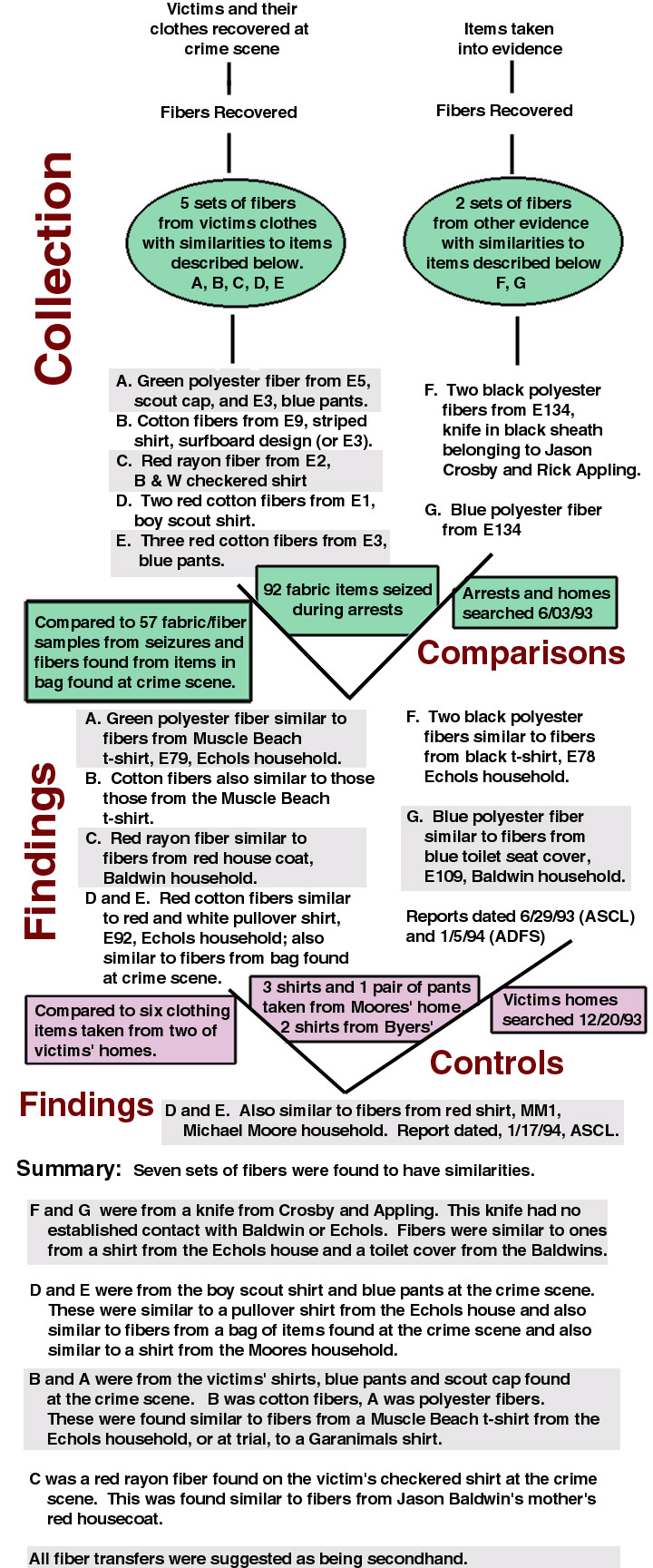
Recommended reading, "Fiber Evidence" from Hair, Fibers, Crime and Evidence. Douglas Deedrick, FBI. In Forensic Science Communications, 2:(3) |


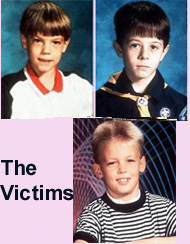
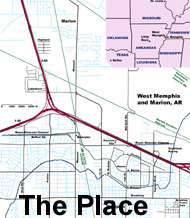

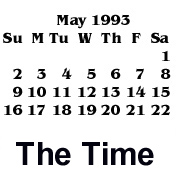


![]()